 |
 |
 |
| |
by Richard Lunsford
Hello & welcome to our concise guide to
browsing U.S. turtles! We cover the bulk of U.S. species by level of overall
difficulty to help you pick a pet & prepare for it. This is a browsing article,
not a care sheet or in-depth analysis (for in-depth help choosing a good
‘starter’ turtle, read our article on
Choosing Your First Turtle (we also have
Choosing Your First Land-based Turtle)).
Important Factors to consider assessing Difficulty
Level:
Hardiness - Hardy turtles (common snappers, RES,
stinkpots) are easier to keep than delicate (Softshells & Cagles & Black-knobbed
maps need pristine water quality; hatchling chicken & 3-striped mud turtles are
problem-prone).
Size - Smaller turtles (stinkpots, southern painteds,
male Texas maps) are easier to spaciously house indoors than medium/large
(sliders, cooters) or huge (female softshells, common snappers) species.
Caveat: small species (southern painteds, stinkpots) mean smaller hatchlings
which may be frailer than larger ones (RES).
Environmental Needs - Turtles who can handle simple,
deep-water aquarium setups are easier than those needing palludarium-style (spotteds,
bog, muds) or large mixed environments (North American wood turtles).
Cost - Inexpensive turtles (stinkpots, southern
painteds) are easier to get than moderately expensive (Texas maps, loggerhead
musk, Eastern box), expensive (stripe-neck musk, spotted, Blandings, North
American Wood).
Ease of Acquisition – Commonly available (stinkpots)
are more desirable than the rare (stripe-neck musk) for beginners.
Community-compatibility – Turtles who often do well
in mixed setups (cooters, sliders, painteds, stinkpots) are preferable to those
needing solo-enclosures (snappers).
Nutrition – generalist omnivores & carnivores are a
better match for the diets keepers offer than strict herbivores.
Your Situation – You may have situational advantages
or disadvantages most people don’t. Eastern or 3-toed box keeping can be easy in
large outdoor pens in their native range. Year-round outdoor keeping of red-foot
tortoises is easier in southern Florida than Wyoming. A big yard in the
southwest may simplify Sulcata ownership. An upper-level apartment with weak
floors may not tolerate a huge setup. Your Florida Koi pond, properly adapted,
might handle a Florida Red-belly turtle just fine.
Provided Information – In the spirit of
light-reading, I’ll provide a brief blurb about each hitting on what’s relevant;
common names are hyper-linked to ATP Care Sheets where available. Description
briefly sums up size (small, medium, large or a range), significant details if
any & type (basking species, bottom walker, terrestrial semi-aquatic (most time
spent on land), aquatic semi-terrestrial (most time spend in water),
terrestrial). Pro.s lists prime selling points of the species, & Con.s
problems with it. Cost is just for the turtle; from online vendors add about
$20-25 overnight shipping (for the whole order), & for expo.s add roughly $5-10
entrance fee.
Section I
– The Best Starter Turtles.
Small, fairly hardy, affordable, readily
available, simple enclosure needs. Can be kept in tanks minimum 29
gallons (55 for female southern & midland painteds) & should prosper in 75
gallon+.
1.)
Southern Painted Turtle -
Chrysemys picta dorsalis
Description: Small basking turtle, fairly
hardy adults, care like sliders. Black carapace, scutes have some light trip,
red dorsal red stripe, plain plastron. Size: Males 3.5 – 5”; females 5.5
– 7”.
Pro.s: Small adult size (males < females),
omnivorous, usually peaceful, common & inexpensive, can hibernate in the
southern U.S. Fairly personable/interactive with humans.
Con.s: Hatchlings reputedly delicate.
Plastron plain compared to Western & Midland painteds. Not appropriate for
northern winter hibernation.
Availability & Cost: Very common at online
vendors & expo.s. ~ $15 for hatchlings.
|
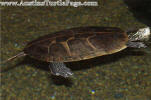 |
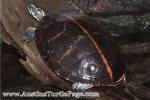 |
|
Male Southern Painted
Photo
by Richard Lunsford |
Female Southern Painted
Photo
by Richard Lunsford |
2.) (Male)
Midland Painted Turtle -
Chrysemys picta marginata
Description: Small-to-Medium basking turtles,
fairly hardy, care like sliders. Green to black carapace (usually greener),
faint or no dorsal stripe, plastron with moderate ‘color splash.’ Size:
Males 4 – 6”; females 6 – 8”.
Pro.s: Small adult size (males < females),
omnivorous, usually peaceful, common & inexpensive, hibernation-capable (occur
further north than Southern Painteds). Plastron has a colorful pattern (unlike
southern & eastern painteds). Fairly personable/interactive with humans.
Con.s: A little larger than S. painted. Less
ornate plastron than Western painted. Carapace color varies – green to black (so
your hatchling may not look like the one in a photo).
Availability & Cost: Very common at online
vendors & expo.s. ~ $15 for hatchlings.
|
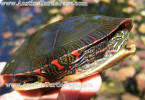 |
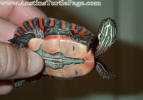 |
|
Midland Painted
Photo by Tim M. |
Plastron Shot
Photo
by Tom C. |
3.) (Male)
Eastern Painted Turtle –
Chrysemys picta picta
Description: Small-to-Medium basking turtles
(males < females), hardy, standard slider care. Black carapace, light trim on
scutes, red-orange underside of carapace, bland plastron. Sizes: Males 4
– 6”; females 6 – 8+”.
Pro.s: Omnivorous, smaller than sliders,
hardy, usually peaceful, fairly common & inexpensive, hibernation-capable (occur
further north than Southern Painteds). Fairly personable/interactive with
humans.
Con.s: Larger than southern (& lack the
dorsal stripe); bland plastron unlike midland & western painteds; large females
deserve 75+ gallon tanks.
Availability & Cost: Fairly common at online
vendors & expo.s. ~ $15 for hatchlings.
|
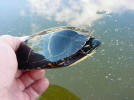 |
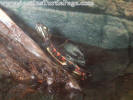 |
|
Eastern Painted
Photo by Keith B. |
Eastern Painted
Photo by Tom C. |
4.) (Male)
Texas Map Turtle -
Graptemys versa
Description: Small basking turtle, fairly
hardy adults, care like sliders. Olive brown carapace with intricate designs (or
algae covered!). Sizes: Males 2.75 – 4.5”, Females 4 – 8 3/8”.
Pro.s: Small adult size (males only; females
similar in size to male RES!), omnivorous (but more carnivorous than painteds),
fairly nonchalant personality – less prone to skittishness than some maps.
Fairly personable/interactive with humans.
Con.s: Hatchlings of small species tend to be
delicate. May (especially females) be aggressive toward other turtles. Maps (but
not specifically this species) have a rep. for being sensitive to water quality.
Carapace prone to algal overgrowth. Texas native not a good candidate for
hibernation.
Availability & Cost: Somewhat uncommon at
online vendors; may appear at larger expo.s. ~ $25-40 for hatchlings.
|
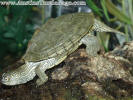 |
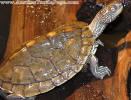 |
|
Male Texas Map
Photo
by Richard Lunsford |
Male Texas Map
Photo by Tom C. |
5.) (Male)
Common Map Turtle -
Graptemys geographica
Description: Small to medium basking turtle,
fairly hardy adults, care like sliders. Olive-brown carapace, intricate markings
(fade with growth & age), bar across eye pupil, many males & juveniles appear to
have a smiling face. Sizes: Males 4 – 6.25”, Females 7 – 10.75”.
Pro.s: Small to medium adult size (males
only; females similar to RES!). Mainly carnivorous. Inhabit streams in addition
to rivers, so in theory may be better adapted to enclosures than some
maps. Tom C. thinks they may be less prone to water quality-related problems
than some other maps. Hibernation-capable.
Con.s: Larger than Texas maps. Less prominent
keeling along dorsal spine than many maps. Carapace prone to algal overgrowth.
Somewhat hard to find in the pet trade.
Availability & Cost: Uncommon at online
vendors & expo.s. ~ $20 for hatchlings.
|
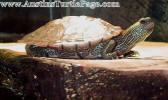 |
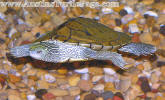 |
|
Male Common Map
Photo
by Tom C. |
Male Common Map
Photo by Tom
C. |
6.)
Stinkpot (Common Musk)
- Sternotherus odoratus
Description: Small bottom-walker, fairly
hardy adults, care like sliders but with much more submerged items to clamber
around on near the surface. Carapace generally black; some brownish. Yellow
‘lightening’ stripes on side of head/face. Size: 2 – 5” (typically around
4”).
Pro.s: Small adult size, mainly carnivorous,
common, inexpensive, hibernation-capable. Adults can be housed in tanks small as
29 gallon (minimum).
Con.s: Hatchling musk somewhat delicate.
Prone to aggression toward their own kind & ‘look-a-likes.’ Less likely to be
personable than sliders.
Availability & Cost: Very common at online
vendors & expo.s. ~ $15 for hatchlings.
|
 |
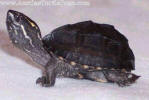 |
|
Adult Female Stinkpot
Photo by Richard Lunsford |
Juvenile Stinkpot
Photo
by Lisa |
7.)
Razorback Musk
- Sternotherus carinatum
Description: Small bottom-walker (but larger
than stinkpots), fairly hardy adults, care like sliders but with much more
submerged items to clamber around on near the surface. Tan brown carapace with
dark streaks; pale skin with black specks. Size: 4 – 6”.
Pro.s: Small adult size, mainly carnivorous,
common, inexpensive, hibernation-capable in the southern U.S.
Con.s: Hatchling musk somewhat delicate. Musk
turtles generally are regarded as prone to aggression toward their own kind &
‘look-a-likes.’ Less likely to be personable than sliders. Reputedly shier than
stinkpots or loggerhead musk.
Availability & Cost: Very common at online
vendors & expo.s. ~ $15 for hatchlings.
|
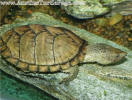 |
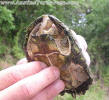 |
|
Female Sub-adult
Photo
by Richard Lunsford |
Cantankerous Wild Adult
Photo by Kent H. |
Section II
– Second Choice Starter Turtles.
Per Section I but with one or more moderate
drawbacks, such as being problem-prone if water quality isn’t high, delicacy as
hatchlings or rarity & cost.
1.) (Male)
Cagles Map Turtle -
Graptemys caglei
Description: Small basking turtle, quite
ornate coloration, care like sliders. Sizes: Males 2.75 – 5”,
Females 4” to 7 15/16”.
Pro.s: Small adult size (males only; females
similar in size to male RES!), omnivorous (but more carnivorous than painteds),
more ornate coloration than a Texas map.
Con.s: Hatchlings of small species tend to be
delicate. Larger than a Texas map. Lacks the Texas map’s rep. for nonchalant
personality. Much more expensive. Carapace prone to algal overgrowth. Have a
rep. for being prone to health problems with sub-optimal water quality. Texas
native not a good candidate for hibernation.
Availability & Cost: Fairly common to
uncommon at online vendors; may appear at larger expo.s. ~ $130 for hatchlings.
|
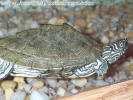 |
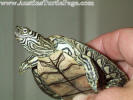 |
|
Cagle’s Map
Photo
by Tom C. |
Cagle’s Map Plastron
Photo by
Tom C. |
2.) (Male)
Black-Knobbed Map Turtle -
Graptemys nigrinoda
Description: Small basking turtle, prominent
black-tipped dorsal carapace spine knobs, care like sliders. There are 2
subspecies but native range very small. Sizes: Males 3 – 4”, Females 6 –
8.5”.
Pro.s: Small adult size (males only; females
similar in size to male RES!), omnivorous (but more carnivorous than painteds),
prominent black-tipped knobs provide a strong ‘classic’ map turtle appearance.
Con.s: Alabama & Mississippi native not a
good candidate for hibernation further north (so only in very southern U.S.).
Somewhat expensive.
Availability & Cost: Fairly common to
uncommon at online vendors; may appear at larger expo.s. ~ $40 for hatchlings.
|
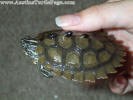 |
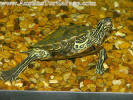 |
|
Male Black-knobbed Map
Photos by Tom C. |
3.) (Male sub-adult)
Chicken Turtle -
Deirochelys reticularia
Description: Medium basking turtle,
reticulated carapace, more pointed face than sliders, long-neck, have ‘strike &
suck’ maneuver to catch prey. Size: Males 4 – 7”, Females up to 10”.
Pro.s: Medium adult size (males online;
female similar to RES), predominantly carnivorous, capable fishermen, fairly
personable (like painteds; less frantic than sliders), hibernation-capable in
their native range.
Con.s: Relatively short-lived (estimated up
to 20 years in captivity), rather thin shells (a factor in falls & crushing
accidents), can be hard to find, expensive, hatchlings are considered delicate &
prone to die despite good care, may kill most of your (non-feeder) fish. The
Florida chicken turtle is most common in the pet trade, & in theory least
hibernation-capable.
Availability & Cost: Uncommon at online
vendors & expo.s but can be found. ~ $50-75 for hatchlings.
|
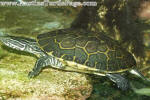 |
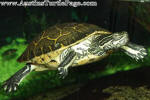 |
|
Male Chicken Turtle
Photo
by Richard Lunsford |
Male Chicken Turtle
Photo
by Richard Lunsford |
4.)
Loggerhead Musk Turtle -
Sternotherus minor minor
Description: Small bottom-walker, adults
(especially older males) may develop huge heads, fairly hardy adults, care like
sliders but with much more submerged items to clamber around on near the
surface. Size: 3 – 5.5”.
Pro.s: Small adult size, mainly carnivorous,
distinctive-looking.
Con.s: Hatchling musk somewhat delicate. Huge
heads aren’t to everyone’s taste. Musk turtles generally are regarded as prone
to aggression toward their own kind & ‘look-a-likes.’ Less likely to be
personable than sliders. Southeastern U.S. native shouldn’t be hibernated
outside its native range or similar conditions.
Availability & Cost: Uncommon at online
vendors & expo.s. Protected in Florida, where many online vendors are located. ~
$40 for hatchlings.
|
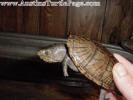 |
|
Adult Loggerhead Musk
Photo by Phil Peak |
5.) Stripe-neck Musk Turtle -
Sternotherus minor
peltifer
Description: Small bottom-walker, fairly
hardy adults, nutmeg coloration on head, care like sliders but with much more
submerged items to clamber around on near the surface. Size: Up to 4 ¾”.
Pro.s: Small adult size, mainly carnivorous,
ornate & distinctive-looking, inexpensive.
Con.s: Hatchlings somewhat delicate.
Expensive & hard to find. Musk turtles generally are regarded as prone to
aggression toward their own kind & ‘look-a-likes.’ Less likely to be personable
than sliders. Southeastern U.S. native shouldn’t be hibernated outside its
native range or similar conditions.
Availability & Cost: Uncommon at online
vendors & expo.s.
|
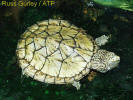 |
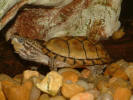 |
|
Stripe-neck Musk Turtle
Photo by Russ Gurley |
Sub-adult Male Stripe-neck Musk Turtle
Photo by Xavier |
6.) 3-Striped Mud Turtle -
Kinosternon baurii
Description: Small bottom-walker, fairly
hardy adults, blackish coloration with shell stripes & yellow ‘lightening’
stripes on the head, need palludarium-style shallow water enclosures with
sizeable land area. Size: 3 – 4”.
Pro.s: Small adult size, mainly carnivorous,
most ornate of the U.S. mud/musk, inexpensive. Reputedly have ‘stinkpot-like’
personalities (less shy than young Mississippi muds).
Con.s: Hatchlings delicate, a drowning risk &
require very shallow water the first few months. Somewhat hard to find.
Mud turtles generally are regarded as prone to aggression toward their own kind
& ‘look-a-likes.’ Less likely to be personable than sliders. Southeastern U.S.
native shouldn’t be hibernated outside its native range or similar conditions.
Availability & Cost: Less common at online
vendors but cheap. ~ $15.
|
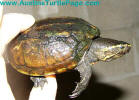 |
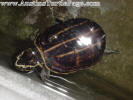 |
|
Adult 3-Striped Mud Turtle with old Carapace
Injury
Photo by Tom C. |
Adult 3-Striped Mud Turtle
Photo
by Phil Peak |
7.) Eastern Mud Turtle -
Kinosternon subrubrum
subrubrum
Description: Small bottom-walker, fairly
hardy adults, olive brown coloration, care with palludarium-style shallow-water
enclosures with sizeable land area. Size: 3 – 5”.
Pro.s: Small adult size, mainly carnivorous,
inexpensive. Has been known to eat out of water. Can be adundant in tidal
marshes & is tolerant of brackish water. In the wild may hibernate on land
or
in water.
Con.s: Hatchling muds somewhat delicate, a
drowning risk & require very shallow water the first few months. Adults
remain a drowning risk (more of a rep. for this than 3-striped muds) & need
shallow water enclosures (which don’t work for many popular tank-mates painteds).
May aestivate extended periods if provided land section to burrow into. Drab
compared to 3-striped & Mississippi muds (no yellow head stripes). Somewhat hard
to find. Mud turtles generally are regarded as prone to aggression toward their
own kind & ‘look-a-likes.’ Less likely to be personable than sliders.
Southeastern range extends up the East coast so can hibernate, but drowning risk
vs. need for deep outdoor enclosures for hibernation may complicate year round
outdoor keeping.
Availability & Cost: Uncommon at online
vendors but cheap. ~ $15.
8.)
Mississippi Mud Turtle -
Kinosternon subrubrum hippocrepis
Description: Small bottom-walker, fairly
hardy adults, olive brown coloration, care with palludarium-style shallow-water
enclosures with sizeable land area. A subspecies of the Eastern mud. Size:
3 – 5”.
Pro.s: Small adult size, mainly carnivorous,
common & inexpensive.
Con.s: Hatchling muds somewhat delicate, a
drowning risk & require very shallow water the first few months. Adults
remain a drowning risk (more of a rep. for this than 3-striped muds) & need
shallow water enclosures (which don’t work for many popular tank-mates like
painteds). May aestivate extended periods if provided land section to burrow
into. Drab compared to 3-striped muds. Somewhat hard to find. Mud turtles
generally are regarded as prone to aggression toward their own kind &
‘look-a-likes.’ Less likely to be personable than sliders. Southcentral range
extends far enough north to hibernate (in the southern U.S.), but drowning risk
vs. need for deep outdoor enclosures for hibernation may complicate year round
outdoor keeping.
Availability & Cost: Fairly common at online
vendors & cheap. ~ $15.
|
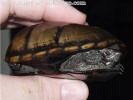 |
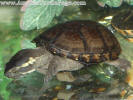 |
|
Adult Mississippi Mud
Photo
by Richard Lunsford |
Juvenile Mississippi Mud
Photo
by Richard Lunsford |
9.) Yellow Mud Turtle -
Kinosternon flavescens
flavescens
Description: Small bottom-walker, fairly
hardy adults, variable olive to brown coloration (often lighter than an Eastern
mud), lower jaw lighter (can give a ‘smiling’ appearance vaguely like a
Blandings), care with palludarium-style shallow-water enclosures with sizeable
land area. Size: 4 – 5.”
Pro.s: Small adult size, mainly carnivorous,
look like they’re smiling. Hibernate in parts of their range.
Con.s: Hatchlings muds somewhat delicate, a
drowning risk & require very shallow water the first few months. Adults
need shallow water enclosures (which don’t work for many popular tank-mates like
painteds). May aestivate extended periods if provided land section to burrow
into. Drab compared to 3-striped muds. Somewhat hard to find. Mud turtles
generally are regarded as prone to aggression toward their own kind &
‘look-a-likes.’ Less likely to be personable than sliders. Central range extends
far enough north to hibernate (in theory those of southern ancestry might be
less capable), but details aren’t well-known (like land vs. water preference!)
so not recommended except in large, naturalistic outdoor enclosures in their
native range.
Availability & Cost: Uncommon at online
vendors, & hatchlings may be hard to come by. ~ $20 (may not be hatchlings).
|
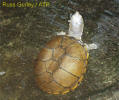 |
|
Yellow Mud Turtle
Photo by Russ Gurley |
Section III
– Medium-Level Turtles.
Medium-sized & need larger enclosures or
otherwise demand more expensive &/or specialized enclosures.
1.) Sliders.
a.
Red-eared Slider (RES) -
Trachemys
scripta elegans
Description: Medium-large basking turtles
(males < females), hardy, standard slider care is based on these!
Variably bright green hatchlings with a red streak/patch behind each eye;
coloration often fades & darkens in adults. Size: Males to 8“,
Females to 11”.
Pro.s: Omnivorous but more herbivorous with
age, hardy, usually peaceful, very common & inexpensive, hibernation-capable.
Plastron has black spots. Fairly personable/interactive with humans. Affordable
color morphs available (albino, pastel, ghost, caramel, etc…). There’s a ‘Rio
Grande’ slider called the Ornate RES (more expensive).
Con.s: Larger than painteds; large females
deserve 125+ gallon tanks. Bright coloration often fades with age (melanism).
May out-compete tank-mates.
Availability & Cost: Very common at
online vendors & expo.s. ~ $5-10 for hatchlings (color morphs much more
expensive).
|
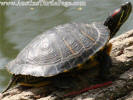 |
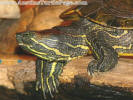 |
|
RES
Photo
by Richard Lunsford |
RES
Photo by Tom C |
b.
Yellow-bellied Slider (YBS) -
Trachemys scripta scripta
Description: Medium-large basking turtles
(males < females), hardy, standard slider care. Variably bright green hatchlings
with a diagonal yellow slash behind each eye; coloration often fades & darkens
in adults. May be more domed than RES (possibly to resist alligator bites).
Size: Males to 8“, Females to 11”.
Pro.s: Omnivorous but more herbivorous with
age, hardy, usually peaceful, fairly common & inexpensive, hibernation-capable
(but don’t occur as far north or inland as RES). Plastron has black spots.
Fairly personable/interactive with humans.
Con.s: Larger than painteds; large females
deserve 125+ gallon tanks. Bright coloration often fades with age (melanism).
Less striking appearance than RES. May out-compete tank-mates.
Availability & Cost: Fairly common at online
vendors & expo.s. ~ $5-10 for hatchlings.
|
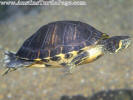 |
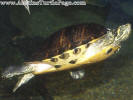 |
|
Male YBS
Photo
by Richard Lunsford |
c. Cumberland Slider
- Trachemys scripta troostii
Description: Medium-large basking turtles
(males < females), hardy, standard slider care. Variably bright green hatchlings
lacking the red patch of RES & diagonal yellow slash of YBS; coloration often
fades & darkens in adults. Size: Females to 9”, Males smaller.
Pro.s: Omnivorous but more herbivorous with
age, hardy, usually peaceful, fairly inexpensive, hibernation-capable. Plastron
has black spots. Typically smaller than RES & YBS. Fairly personable/interactive with humans.
Con.s: Larger than painteds; large females
deserve 125+ gallon tanks. Bright coloration often fades with age (melanism).
Less striking appearance than RES or YBS. May out-compete tank-mates.
Availability & Cost: Uncommon at online
vendors & expo.s. ~ $10 for hatchlings.
|
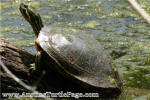 |
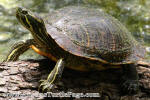 |
|
Female Cumberland Slider
Photo
by Richard Lunsford |
2.) Cooters (Warning: Hatchlings & Adults look a
lot different). Some Cooters’ palates have ‘cusps’ that look like teeth.
a.
Florida Red-bellied Turtle –
Pseudemys nelsoni
Description: Large basking turtles (males <
females), hardy, standard slider care. Bright green hatchlings; coloration
changes & darkens in adults to a dark red/black base; yellow stripes on black
skin head pattern. Adult females very thick-bodied. Size: Florida Red
Belly male 7 – 9,” female 11-13.”
Pro.s: Omnivorous hatchlings but strongly
herbivorous adults, hardy, usually peaceful, fairly inexpensive. Cooters
generally have a rep. for being calmer & more ‘laid back’ than sliders. Fairly
personable/interactive with humans.
Con.s: Larger than sliders; adults deserve
125+ gallon tanks. Adults may have black shells instead of standard coloration.
Florida native so hibernation not advised.
Availability & Cost: Very common at online
vendors & expo.s. ~ $10-15 for hatchlings.
|
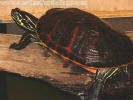 |
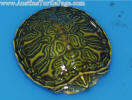 |
|
Adult Female Florida Red-Belly
Photo by Tom C. |
Hatchling Florida Red-belly
Photo
by Richard Lunsford |
b. Alabama Red-bellied Turtle –
Pseudemys
alabamensis
Description: Large basking turtles (males <
females), hardy, standard slider care. Hatchings are dark green with vivid
red-orange plastrons; adults have a much darker carapace. Size: Up to
13”.
Pro.s: Omnivorous hatchlings but strongly
herbivorous adults, hardy, usually peaceful. Cooters generally have a rep. for
being calmer & more ‘laid back’ than sliders. Fairly personable/interactive with
humans.
Con.s: Larger than sliders; adults deserve
125+ gallon tanks. Small southern Alabama range so hibernation not recommended.
Availability & Cost: One of only 2 non-marine
federally endangered turtle species in the United States. The upshot is, can
only be had wild-caught & then illegally.
Click here for a gorgeous photo.
by Robert H. Mount.
Click here to submit your photo for use in
this article
c. Red-Bellied Turtle –
Pseudemys rubriventris
Description: Large basking turtles (males <
females), hardy, standard slider care. Bright green hatchlings; coloration
changes & darkens in adults. Size: Females up to 15”; Males smaller.
Pro.s: Omnivorous hatchlings but strongly
herbivorous adults, hardy, usually peaceful, fairly inexpensive. Cooters
generally have a rep. for being calmer & more ‘laid back’ than sliders. Fairly
personable/interactive with humans. Northeastern range indicates
hibernation-capable.
Con.s: Larger than sliders; adults deserve
125+ gallon tanks.
Availability & Cost: Uncommon at online
vendors & expo.s. ~ $20-25 for hatchlings.
d.
Florida Cooter
– Pseudemys floridana floridana
Description: Large basking turtles (males <
females), hardy, standard slider care. Adult females very thick-bodied. Size:
Males 7.5 – 9”; Females 9 – 16.”
Pro.s: Omnivorous hatchlings but strongly
herbivorous adults, hardy, usually peaceful, fairly inexpensive. Cooters
generally have a rep. for being calmer & more ‘laid back’ than sliders. Fairly
personable/interactive with humans. Southeastern range extends northward enough
that hibernation may be feasible in the south.
Con.s: Larger than sliders; adults deserve
125+ gallon tanks.
Availability & Cost: Uncommon at online
vendors & expo.s. ~ $ for hatchlings.
e. Peninsula Cooter -
Pseudemys floridana
peninsularis
Description: Large basking turtles (males <
females), hardy, standard slider care. Bright green hatchlings; coloration
changes & darkens in adults. Adult females thick-bodied. Size:
Females up to 16”; Males smaller.
Pro.s: Omnivorous hatchlings but strongly
herbivorous adults, hardy, usually peaceful, fairly common & inexpensive.
Cooters generally have a rep. for being calmer & more ‘laid back’ than sliders.
Fairly personable/interactive with humans.
Con.s:
Larger than sliders; adults deserve
125+ gallon tanks. Florida native so hibernation not advised.
Availability & Cost: Common at online vendors
& expo.s. ~ $10-15 for hatchlings.
|
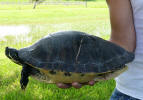 |
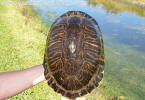 |
|
Female Peninsula Cooter
Photos by Tom C. |
f. River Cooter – Pseudemys concinna (several
subspecies)
Description: Large basking turtles (males <
females), hardy, standard slider care. Green hatchlings; coloration changes &
darkens in adults. Size: Varies with ‘sub-species’ - Eastern Females to ~
15”, but Suwannee Females to 17”! (Males smaller).
Pro.s: Omnivorous hatchlings but strongly
herbivorous adults, hardy, usually peaceful, fairly inexpensive. Some are quite
colorful/well-patterned. Cooters generally have a rep. for being calmer & more
‘laid back’ than sliders. Fairly personable/interactive with humans. Some
subspecies occur far enough north to hibernate.
Con.s: Larger than sliders & even the other
cooters; adults deserve 125+ gallon tanks. The Suwanne subspecies is confined to
Florida so don’t hibernate them.
Availability & Cost: at online vendors &
expo.s. ~ $10-15 for hatchlings.
|
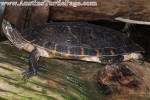 |
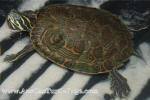 |
|
Adult Male River Cooter
Photo
by Richard Lunsford |
Young River Cooter
Photo
by Richard Lunsford |
g. Rio Grande Cooter -
Pseudemys gorzugi
Description: Large basking turtles (males <
females), hardy, standard slider care. Bright green hatchlings; adults have a
green swirled carapace with red-orange winding roads & an ornatedly black
spotted red-orange underside of the carapace. Size: Up to 9.5” (Small for
a Cooter!).
Pro.s: Omnivorous hatchlings but strongly
herbivorous adults, hardy, usually peaceful, beautifully ornate. Cooters
generally have a rep. for being calmer & more ‘laid back’ than sliders.
Fairly small for a cooter. Fairly
personable/interactive with humans.
Con.s: Larger than sliders; adults deserve
125+ gallon tanks. Uncommon & expensive. Largely a Texas native so hibernation
not advised.
Availability & Cost: Uncommon at online
vendors & expo.s. ~ $65 for hatchlings.
|
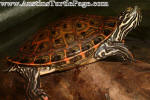 |
 |
|
Rio Grande Cooter
Photos by Xavier |
h. Texas Cooter –
Pseudemys texana
Description: Large basking turtles (males <
females), hardy, standard slider care. Dank greenish hatchlings; adults have a
patterned greenish to ‘brown & yellow’ coloration. Adult females thick-bodied.
Size: Females to 13”; Males smaller.
Pro.s: Omnivorous hatchlings but strongly
herbivorous adults, hardy, usually peaceful, beautifully ornate. Cooters
generally have a rep. for being calmer & more ‘laid back’ than sliders. Fairly
personable/interactive with humans.
Con.s: Larger than sliders; adults deserve
125+ gallon tanks. Uncommon & expensive. Largely a Texas native so hibernation
not advised.
Availability & Cost: Uncommon at online
vendors & expo.s. ~ $30 for hatchlings. Tom C. knows them to be widely abundant
in Texas, yet hardly anyone shows interest in breeding them! I've seen Turtle
Pimp offer these.
|
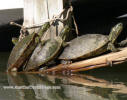 |
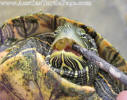 |
|
Texas Cooters
Photo
by Turdle |
Texas Cooter
Photo by Tom C. |
3.) (Female)
Midland Painted Turtle -
Chrysemys picta marginata
Description: Small-to-Medium basking turtles,
fairly hardy, care like sliders. Green to black carapace (usually greener),
faint or no dorsal stripe, plastron with moderate ‘color splash.’ Size:
Males 4 – 6”; females 6 – 8”.
Pro.s: Medium adult size (males < females),
omnivorous, usually peaceful, common & inexpensive, hibernation-capable (occur
further north than Southern Painted). Plastron has a colorful pattern (unlike
southern & eastern painteds). Fairly personable/interactive with humans.
Con.s: A little larger than S. painted. Less
ornate plastron than Western painted. Carapace color varies – green to black (so
your hatchling may not look like the one in a photo).
Availability & Cost: Very common at online
vendors & expo.s. ~ $15 for hatchlings.
|
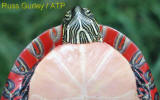 |
|
Female Midland
Painted
Photo by Russ Gurley |
4.) (Female)
Eastern Painted Turtle –
Chrysemys picta picta
Description: Small-to-Medium basking turtles
(males < females), hardy, standard slider care. Black carapace, light trim on
scutes, red-orange underside of carapace, bland plastron. Size: Males 4
– 6”; females 6 – 8+”.
Pro.s: Omnivorous, slightly smaller than
sliders, hardy, usually peaceful, fairly common & inexpensive,
hibernation-capable (occur further north than Southern Painted). Fairly
personable/interactive with humans.
Con.s: Larger than southern or midland
painteds; bland plastron unlike midland & western painteds; large females
deserve 75+ gallon tanks.
Availability & Cost: Fairly common at online
vendors & expo.s. ~ $15 for hatchlings.
|
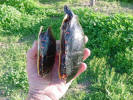 |
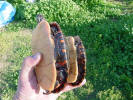 |
|
Eastern Painteds - Male (left),
Female (right)
Photo by Keith B. |
Eastern Painteds - Female (left), Male (right)
Photo by Keith B. |
5.)
Western Painted Turtle –
Chrysemys picta bellii
Description: Medium-large basking turtles
(males < females), hardy, standard slider care. Variably green carapace,
red-orange underside of carapace, fiery explosion of color on plastron. Size:
Males 4 – 7”; females 8 – 10”.
Pro.s: Omnivorous, slightly smaller than
sliders, hardy, usually peaceful, outstanding ventral view, fairly common &
inexpensive, hibernation-capable (occur further north than RES). Fairly
personable/interactive with humans.
Con.s: Larger than southern or midland
painteds. Large females deserve 125+ gallon tanks.
Availability & Cost: Fairly common at online
vendors & expo.s. ~ $15 for hatchlings.
|
_small.JPG) |
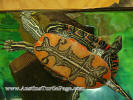 |
|
Male Western Painted
Photo
by Richard Lunsford |
Male Western Painted
Photo by
Tom C. |
|
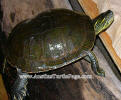 |
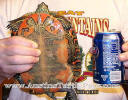 |
|
Female Western Painted
Photos by Tom C. |
6.) Most
Map Turtles, including females. Map turtles has a group have a
reputation for being unusually sensitive to poor water quality (Cagles &
Black-knobbed have specifically been mentioned; Tom C. thinks common maps may be
more resistant) & skittishness (Mississippi maps have specifically been
mentioned; Texas maps may be an exception). In all maps the female is
drastically larger than the male.
a. Mississippi Map –
Graptemys psuedogeographica kohni
Description: Medium-large basking turtles
(males < females), standard slider care. Olive-brownish carapace with intricate
patterns that fade with growth & age; patterned plastron. Striking eyes with
bright iris around pupil (no bar across it) & a yellow crescent curving behind &
under the eye. Probably the most common map in the pet trade. Size:
Males 3.5 – 5”, Females 6 – 10”.
Pro.s: Predominantly carnivorous, males
smaller than sliders, usually peaceful, common & inexpensive,
hibernation-capable.
Con.s: Large females deserve 125+ gallon
tanks. Rep. for skittishness.
Availability & Cost: Common at online vendors
& expo.s. ~ $10-15 for hatchlings.
|
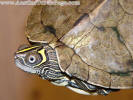 |
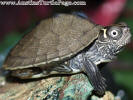 |
|
Adult Male Mississippi Map
Photo by Tom C. |
Hatchling Mississippi Map
Photo
by Richard Lunsford |
b.
False Map –
Graptemys psuedogeographica psuedogeographica
Description: Medium-large basking turtles
(males < females), standard slider care. Olive-brownish carapace with intricate
patterns that fade with growth & age; patterned plastron. Less bright iris
around pupil (which may have a bar or partial bar across it) & a yellow bar
behind the eye. Size: Male 3 ½” - 5 ¾” Female 5" - 11”
Pro.s: Predominantly carnivorous, males
smaller than sliders, usually peaceful, fairly inexpensive, hibernation-capable.
Con.s: Large females deserve 125+ gallon
tanks.
Availability & Cost: Uncommon at online
vendors & expo.s. ~ $15 for hatchlings.
|
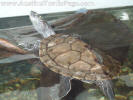 |
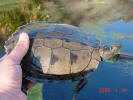 |
|
Adult Male False Map
Photo by
Tom C |
Adult Female False Map
Photo by Keith B. |
|
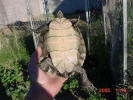 |
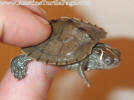 |
|
Adult Female False Map
Photo by Keith B. |
Juvenile False Map
Photo by
Tom C |
c.
Ouachita Map –
Graptemys ouachitensis ouachitensis
Description: Medium-large basking turtles
(males < females), standard slider care. Olive-brownish carapace with intricate
patterns that fade with growth & age; patterned plastron. Fairly bright iris
around pupil (which may have a bar or partial bar across it) & a yellow bar
behind the eye. Size: Male 3 ½” – 5.5” Female 5" - 10 ¾.
Pro.s: Predominantly carnivorous, males
smaller than sliders, usually peaceful, fairly common & inexpensive,
hibernation-capable.
Con.s: Large females deserve 125+ gallon
tanks.
Availability & Cost: Common at online vendors
& expo.s. ~ $15 for hatchlings.
|
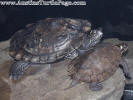 |
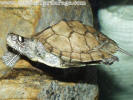 |
|
Female & Male Ouachita Map
Photo
by Richard Lunsford |
Male Ouachita Map
Photo
by Richard Lunsford |
d. Female
Common Map –
Graptemys geographica
Description: medium-large basking turtle,
fairly hardy adults, care like sliders. Olive-brown base color, intricate
markings (fade with growth & age), bar across eye pupil, many males appear to
have a smiling face less evident in females. Size: Males 4 – 6.25”,
Females 7 – 10.75”.
Pro.s: Medium-large adult size similar to
RES. Mainly carnivorous. Inhabit streams in addition to rivers, so in theory
may be better adapted to enclosures than some maps. Tom C. thinks they may be
less prone to water quality-related problems than some other maps.
Hibernation-capable.
Con.s: Less prominent keeling along dorsal
spine than many maps. Carapace prone to algal overgrowth. Somewhat hard to find
in the pet trade.
Availability & Cost: Uncommon at online
vendors & expo.s. ~ $
|
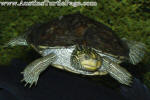 |
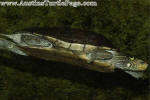 |
|
Female Common Map
Photo
by Richard Lunsford |
Female Common Map
Photo
by Richard Lunsford |
e.
Barbour’s Map –
Graptemys barbouri
Description: Medium (males) to large
(females) basking turtles (males < females), standard slider care.
Olive-brownish carapace with intricate patterns that fade with growth & age;
patterned plastron. Colorful head markings. Barbours are one of the broad-head
maps, & females can get very large heads/jaws & cooter-sized bodies. Size:
Males 3.5 – 5,” Females 7 – 13.”
Pro.s: Predominantly carnivorous, usually
peaceful.
Con.s: Large females deserve 125+ gallon
tanks. The enlarged crushing jaws of females could in theory inflict severe
bites. Somewhat hard-to-find in the pet trade & expensive. Due to southeastern
range I don’t recommend hibernation outside native range conditions.
Availability & Cost: Uncommon at online
vendors & expo.s. ~ $75 for hatchlings.
|
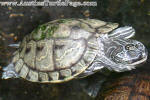 |
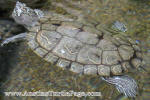 |
|
Female Barbour’s Map
Photo
by Richard Lunsford |
Female Barbour’s Map
Photo
by Richard Lunsford |
|
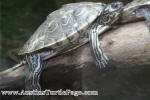 |
|
Male Barbour’s Map
Photo
by Richard Lunsford |
7.) Female
Chicken Turtle -
Deirochelys reticularia
Description: Large basking turtle,
reticulated carapace, more pointed face than sliders, long-neck, have ‘strike &
suck’ maneuver to catch prey. Female Florida subspecies can be quite thick.
Size: Males 4 - 7” Females up to 10”.
Pro.s: Medium adult size (males online;
female similar to RES), predominantly carnivorous, capable fishermen, fairly
personable (like painteds; less frantic than sliders), hibernation-capable in
their native range.
Con.s: Relatively short-lived (estimated up
to 20 years in captivity), rather thin shells (a factor in falls & crushing
accidents), can be hard to find, expensive, hatchlings are considered delicate &
prone to die despite good care, may kill most of your (non-feeder) fish. The
Florida chicken turtle is most common in the pet trade, & in theory least
hibernation-capable.
Availability & Cost: Uncommon at online
vendors & expo.s but can be found. ~ $50-75 for hatchlings.
|
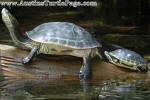 |
|
Female & Male Chicken Turtle (size difference
perhaps slightly exaggerated, but not much!)
Photo
by Richard Lunsford |
|
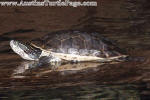 |
|
Female Chicken Turtle
Photo
by Richard Lunsford |
8.) Florida Mud Turtle -
Kinosternon subrubrum
steindachneri
Description: Small bottom-walker, fairly
hardy adults, olive brown coloration, most reduced plastron of any U.S. mud
turtle, care not well-known but at least some shallow water areas & at least a
small land area recommended. They’re a subspecies of the Eastern mud, which
spends a lot of land, making this turtles’ needs hard to call. Size: 4 –
5”.
Pro.s: Small adult size, mainly carnivorous,
reduced plastron suggests better adapted to a more aquatic existence (Peterson’s
Field Guide to Repiles & Amphibians of Eastern/Central North America Page
155 states they’re more aquatic than Eastern muds). Males have larger heads that
may rival male loggerhead musk in size.
Con.s: Hatchling muds somewhat delicate, a
drowning risk & require very shallow water the first few months; to what
extent this applies to Floridas isn’t clear. Adults should have shallow areas in
the tank & a land area. Drab compared to 3-striped & Mississippi muds (no yellow
head stripes). Have a rep. for being hostile when handled. Not everyone likes
the large heads of some males. Somewhat hard to find. Mud turtles generally are
regarded as prone to aggression toward their own kind & ‘look-a-likes.’ Less
likely to be personable than sliders. Florida native not recommended for
hibernation.
Availability & Cost: Uncommon at online
vendors. ~ $.
9.)
Spotted Turtle -
Clemmys guttata
Description: Small moderately-domed black
turtle with small yellow spots. Utilizes both land & water but well-adapted for
water. Care similar to Eastern mud; palludarium-style setup with shallow water.
Adult Size: 3.5 - 5" SCL.
Pro.s: Small, omnivorous, beautiful & fairly
personable/interactive with humans. Fairly easy to find. Northeast & most of
east coast distribution so hibernation-capable.
Con.s: Palludarium-style enclosure with
plenty of shallow water & plenty of land calls for relatively large enclosure
compared to turtle & makes keeping with other popular pets (i.e.: painteds)
impractical. Even adults risk eventually drowning in deeper water enclosures.
Not as heat-tolerant as some species so outdoor enclosures in warmer regions
must include cool areas. Males may relentlessly pursue females (can cause
drownings!) & harass subordinate males. Expensive.
Availability & Cost: Fairly common at online
vendors & expo.s. ~ $125-130 for hatchlings.
Known Legalities: Illegal to possess in
Illinois. Permit required for ownership in SC and MD, & to possess over 5 in VA.
Endangered in IN and IL , threatened in ME,VT,and I believe OH, special concern
in MA, NY, MD, NC, SC and MI, permits are required in NH and RI and VA has
possession limits. CT and NJ also may offer some protection. Consult your state
laws for current regulations.
|
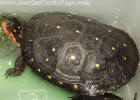 |
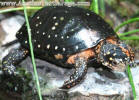 |
|
Adult Spotted Turtle
Photo
by Richard Lunsford |
Adult Spotted Turtle
Photo
by Richard Lunsford |
10.) Softshell Turtles.
a. Male
Spiny Softshell Turtle –
Apalone spiniferus
Description: Very flattened-bodies turtles with
long, tapering faces/noses, lips, strongly webbed feet & leathery, skin-covered
flexible shells. Hatchlings cute & in some subspecies (i.e.: Eastern spiny) have
beautiful rings/ocelli. Females drastically larger than males & the rings/ocelli
diffuse out to form lichen-like patches. Anterior carapace rim has little
thorn-like spines. Slider-like care but beware abrasive objects in the tank; at
least a container of sandy substrate will be appreciated. Sizes (for 4 of
the 7 subspecies): Eastern females 7 - 17 in, males 5 – 9.25 in, Western females
7 – 18 in, males 5 – 7.25 in, Gulf Coast females 7 – 17 7/8 in, males 5 – 8 in.,
Guadalupe females 7 – 16 5/8 in, males 5 – 8.5 in.
Pro.s: Active, elegant swimmers, enthusiastic
feeders, beautiful & very distinctive from hard-shelled turtles. Capable
fishermen. Males often retain juvenile coloration fairly well. Spiny softies are
more prone to bask on emergent objects than smooth softies. Russ Gurley in Keeping & Breeding Freshwater Turtles Page 127 states hatchling spiny
softshells are somewhat more resilient & accepting of a wider range of water
conditions than other species of softshells. Easy to find & cheap.
Con.s: Prone to infection from minor
injuries. Leathery shell offers little protection from predators. More prone to
dehydration out of water than many species. Prefer sandy section of substrate to
burrow into. Fast enough they can be hard to catch in the tank. Can kill your
fish. Juveniles can gorge themselves to death. This active medium-sized turtle
should have at a dead minimum a 75 gallon tank, & 125 gallon is better.
Availability & Cost: Common in the pet trade.
Cost ~ $10-15 for hatchlings.
|
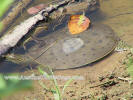 |
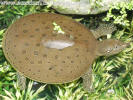 |
|
Adult Wild Male Eastern Spiny
Photo
by Wallob Hebel |
Juvenile Male Eastern Spiny
Photo
by Richard Lunsford |
b. Male Smooth Softshell Turtle –
Apalone muticus
Description: Very flattened-bodies turtles
with long, tapering faces/noses, lips, strongly webbed feet & leathery,
skin-covered flexible shells. Hatchlings cute. Anterior carapace has neither
spines nor tubercles. Females drastically larger than males. Slider-like care
but beware abrasive objects in the tank; at least a container of sandy substrate
will be appreciated. Sizes: Females 6.5 – 14 in, males 4.5 – 7 in.
Pro.s: Active, elegant swimmers, enthusiastic
feeders, beautiful & very distinctive from hard-shelled turtles. Capable
fishermen. Males may be slightly smaller than spiny softshells. Cheap.
Con.s: Prone to infection from minor
injuries. Leathery shell offers little protection from predators. More prone to
dehydration out of water than many species. Prefer sandy section of substrate to
burrow into. Fast enough they can be hard to catch in the tank. Can kill your
fish. Juveniles can gorge themselves to death. Smooth softies are less prone to
bask on emergent objects than spiny softies (many enclosure basking spots are
emergent objects). Harder to find than spiny softies. Have a reputation for
being less hardy than spinies. This active medium-sized turtle should have at
a dead minimum a 75 gallon tank, & 125 gallon is better.
Availability & Cost: Somewhat uncommon in the
pet trade. Cost ~ $10-15 for hatchlings.
c. Chinese Softshell Turtle -
Pelodiscus sinensis
Description: Very flattened-bodies turtles
with long, tapering faces/noses, lips, strongly webbed feet & leathery,
skin-covered flexible shells. Smaller than any North American softshell; even
females (larger than males) are manageable for many. Hatchlings cute & have an
orange plastron. Size: up to 10” SCL.
Pro.s: Active, elegant swimmers, enthusiastic
feeders, beautiful & very distinctive from hard-shelled turtles. Capable
fishermen. Smaller than North American softies. Slider-like care but beware
abrasive objects in the tank; at least a container of sandy substrate will be
appreciated.
Con.s: Prone to infection from minor
injuries. Leathery shell offers little protection from predators. More prone to
dehydration out of water than many species. Prefer sandy section of substrate to
burrow into. Fast enough they can be hard to catch in the tank. Can kill your
fish. Have a rep. for violently defending themselves when handled (which is hard
to do). Harder to find than spiny softies. This active medium-sized turtle
should have at a dead minimum a 75 gallon tank, & 125 gallon is better.
Availability & Cost: Uncommon in the pet
trade but often common in the live turtle food industry (which you fund with
your purchase!).
|
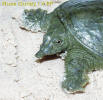 |
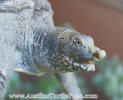 |
|
Chinese Softshell
Photo by
Russ Gurley |
Chinese Softshell
Photo by
Greg Brashear (Snapper Greg) |
11.)
Eastern Box Turtle -
Terrapene carolina Carolina
Description: Medium-sized terrestrial turtle
which likes to soak. Steeply domed carapace, single-hinged plastron, can close
the shell tightly, fairly colorful carapace & head, males & females have
different coloration/patterning. Size: 4.5 – 6.”
Pro.s: Omnivorous. Older juveniles & adults
fairly affable/interactive with humans & shell provides good protection. Eager
feeders. Can be low-maintenance in year-round outdoor enclosures in compatible
climates. Fairly easy to find. Hibernation-capable.
Con.s: Dogs can chew through the shell
quickly. Wild-caught (usual for pet store adults) apt to contain parasites, may
try to hibernate despite not being allowed to do so, & may adjust poorly to
captivity. Require clean water yet preferentially excrete wastes in it. Need
spacious enclosures offering varying temp.s & humidities. May not adapt well to
clear-walled enclosures. May tunnel out of outdoor enclosures. Moderately
expensive. Hatchlings can be maddeningly shy & slow to eat.
Availability & Cost: Fairly common to
somewhat uncommon as hatchlings in the pet trade. Wild-caught adults too common
in pet stores. Cost ~ $25-40 Hatchlings.
|
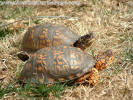 |
|
Eastern Box Turtles
Photo
by Billy (Acutus) |
12.) 3-Toed Box Turtle -
Terrapene carolina truinguis
Description:
Medium-sized terrestrial turtle
which likes to soak. Steeply domed carapace, single-hinged plastron, can close
the shell tightly, males & females have different coloration/patterning. Size:
4.5 – 5.”
Pro.s: Omnivorous. Older juveniles & adults
fairly affable/interactive with humans & shell provides good protection. Eager
feeders. Can be low-maintenance in year-round outdoor enclosures in compatible
climates. Fairly easy to find. Hibernation-capable.
Con.s: Carapace drab compared to Eastern box.
Dogs can chew through the shell quickly. Wild-caught (usual for pet store
adults) apt to contain parasites, may try to hibernate despite not being allowed
to do so, & may adjust poorly to captivity. Require clean water yet
preferentially excrete wastes in it. Need spacious enclosures offering varying
temp.s & humidities. May not adapt well to clear-walled enclosures. May tunnel
out of outdoor enclosures. Moderately expensive. Hatchlings can be maddeningly
shy & slow to eat.
Availability & Cost: Fairly common to
somewhat uncommon as hatchlings in the pet trade. Wild-caught adults too common
in pet stores. Cost ~ $25-45 Hatchlings.
|
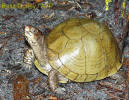 |
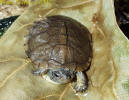 |
|
Male 3-Toed Box
Turtle Photo by
Russ Gurley |
Male 3-Toed Box
Turtle
Photo by
Russ Gurley |
Section IV
– Medium-Hard Level Turtles.
Medium-to-large animals requiring large
enclosures or a higher degree of expertise in care or trouble-shooting when
problems arise.
1.) Blandings Turtle - Emydoidea blandingii
Description: Medium-large semi-aquatic (more
largely aquatic) with moderately domed black carapace, tiny yellow speckles & in
adults a striking yellow lower jaw. Have ‘strike & suck’ maneuver like chicken
turtles. Females somewhat larger than males. Care similar to slider care but
shallower water & more structures to clamber on. Adult Size: 5 - 10.8" SCL.
Pro.s: Predominantly carnivorous, attractive
coloration, cold-tolerant & hibernation capable (hail from northern U.S. around
the Great Lakes).
Con.s: Need shallower water, more structures
to clamber around on, & may prefer more land area & cooler temperatures than
more Œstandard¹ basking turtles (i.e.: sliders). Hatchlings are somewhat
delicate.
Availability & Cost: Uncommon in the pet
trade. Hatchlings ~ $75-125.
Known Legalities: Endangered in IN. They are
listed as threatened in IA, MN, WI, IL, OH, NY, MA and ME . PA lists them as a
candidate species but cannot yet verify they exist in that state. Consult your
state laws for current regulations.
|
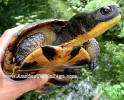 |
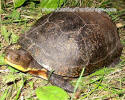 |
|
Blanding's Turtle
Photos by Tim M. |
2.) Pacific Pond Turtle - Actinemys marmorata
(2 subspecies) (Note: Formerly Clemmys marmorata, 'Western' Pond
Turtle).
Description: Medium semi-aquatic (more
largely aquatic) with a brown carapace with streams & speckles. Somewhat
brownish coloration/patterning is surprisingly handsome. Longer tails than most
basking species. Care like sliders but shallower water with more supporting
structures to clamber about on. Size: Up to 8”.
Pro.s: Omnivorous. Distinctive & unusual.
Adult Size: Up to 8" SCL.
Con.s: Not ideal for straight-walled deep
water setups used for many aquatics (i.e.: sliders, painteds). Can be hard to
find. Expensive.
Availability & Cost: Uncommon in the pet
trade & very limited production. Cost: Hatchlings ~$300 (~ 4” SCL juveniles ~
$400).
Known Legalities: Illegal to possess in
Washington, Oregon, and California. Endangered or threatened in the 3-4 states
it occurs in. Consult your state laws for current regulations.
|
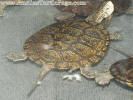 |
|
Sub-Adult Pacific Pond Turtle
Photo
by Richard Lunsford |
3.)
Diamond-Back Terrapin -
Malaclemys terrapin
Description: Medium (male) to large (female)
basking species (7 subspecies), variable brownish carapace, often strikingly
white skin (can be gray, speckled or darker), with black spots & streaks on the
skin. Scutes are raised & have a concentric ring appearance (like pyramiding in
other species). Native to brackish coastal areas of the southeast & south. Care
like sliders but may need brackish water (controversial). Sizes
(of some sub-species): Northern: females 6 – 9”, males 4 – 6.5”. Ornate: females
6 – 9”, males 4 – 6.5.”
Pro.s: Predominantly carnivorous, ornate
coloration, males don’t get as large, captive-breds seem to often do okay in
fresh water if raised in it.
Con.s: Some, especially wild-caught, are
thought susceptible to skin fungal infections unless kept in brackish water. If
kept in brackish water, may need to be offered freshwater occasionally for
drinking. Wild-caughts may not acclimate well. Females get quite large. Males
may be mutually hostile, & even juveniles may turn on each other; jaws designed
to crush shell fish can maim & kill each other. Brackish water is not compatible
with some species you may want later (say, stinkpots). Can be pricy.
Availability & Cost: Uncommon at online
vendors but can be found with persistence. Tracking down a specific subspecies
may be harder. Cost varied by subspecies. Cost: $50-115.
|
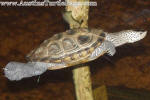 |
|
Diamondback Terrapin
Photo
by Richard Lunsford |
4.)
Common Snapper -
Chelydra serpentina
Description: Large, heavy-bodied & thick
turtle with a rough, bark-like carapace, very reduced plastron, strong & clawed
legs, powerful jaws, long neck, fairly long-range strike & aggressive
self-defense strategy. Long tail. Bottom-walking species that actively prowls in
the wild (not sedentary like alligator snappers). Care is mud turtle-like on
much larger scale but smaller land area needed. Variably dark-brown & drab.
Florida snapper (a subspecies) may be more domed. Wild specimens in the northern
U.S. get larger. Occur in vast array of habitat, water bodies from dirt road
mud-holes (hatchlings) & creeks to large rivers. Size: 8 – 15” (huge old
one may hit 19”). Wild ones run around 20-30+ lbs (larger up north), but
captives can clear 50 lbs.
Pro.s: Omnivorous but often predominantly
carnivorous in captivity. Very hardy. Common & cheap to buy (not own). Eager
feeders & usually feed from the hand. Capable fishermen. Huge native range &
occur in Canada so hibernation-capable.
Con.s: Very large & heavy adults. Grow
quickly. Prone to obesity. Need large enclosures (200 gallon+) with powerful
filtration. Often hostile when handled & can inflict severe injuries. Strike
very fast, fairly long-range, & can spin around very fast. Predatory & may kill
other turtles, even their own kind. Must be housed alone past hatchling stage.
Tend to eat your fish. Often mistaken for alligator snappers by new owners.
Availability & Cost: Common in the pet trade.
Cost ~ $10 for hatchlings.
|
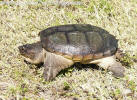 |
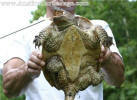 |
|
Adult Common Snapper
Photo
by Tom C. |
Plastral View
Photo
by Richard Gould |
5.) Female
Alligator Snapper -
Macroclemys temmincki
Description: Large, heavy-bodied & thick
turtle with a rough, bark-like carapace, very reduced plastron, strong & clawed
legs, powerful jaws, fairly short-range strike & aggressive self-defense
strategy. Muzzle is longer & has a more hooked ‘beak’ look than a common
snapper. Long tail. Bottom-walking species sedentary in the wild (not as active
a hunter as the alligator snapper). Care is mud turtle-like on much larger scale
(reaching the surface for air without swimming) but smaller land area needed.
Variably dark-brown & drab. Inhabit large, permanent water bodies (mainly
rivers). Size: 15 – 26 in. Males can exceed 200 pounds (150 lbs is large
for a male; heavier weights entail obesity). Females much smaller; reach around
60 - 75 lbs).
Pro.s: Omnivorous but often predominantly
carnivorous in captivity. Fairly hardy. Capable fishermen via wiggling a
worm-like tongue lure (unique to this species). Has a very wild, ‘prehistoric’
look. Safer to handle than a common snapper due to lack of distance ‘power
strike’ & fast body spin. Females max. out much smaller than males. Growth rate
moderate if not over-fed. Less active than common snappers so don’t require much
larger enclosures. Parts of range in temperate climate so should be
hibernation-capable (but a riverine species).
Con.s: Very large, heavy turtle with very
powerful jaws & fairly aggressive disposition (could cost you fingers). Prone to
obesity & grow rapidly if overfed. Need large enclosures (200 gallon+) with
powerful filtration. Hatchlings can’t be sexed by most for years. Predatory &
may kill other turtles. Tend to eat your fish. People seeking these often get
common snappers by mistake; be very sure of what you’re buying.
Availability & Cost: Fairly uncommon at
online vendors. Cost ~ $25-35 for hatchlings.
|
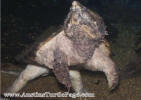 |
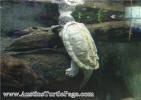 |
|
Female Alligator Snapper
Photo
by Richard Lunsford |
Female Alligator Snapper
Photo
by Richard Lunsford |
6.) Male
Florida Softshell –
Apalone ferox
Description: Very flattened-bodies turtles
with long, tapering faces/noses, lips, strongly webbed feet & leathery,
skin-covered flexible shells. Hatchlings cute & have a ‘smoky leopard’
coloration, but adult coloration varies (dirt/clay brown, tar black, etc…).
Females drastically larger than males. Anterior carapace rim has tubercles
(blunt bumps). Slider-like care but beware abrasive objects in the tank; at
least a container of sandy substrate will be appreciated. Size: Females
11 – 24.75” (must be seen to be believed), males 6 – 12.75.”
Pro.s: Active, elegant swimmers, enthusiastic
feeders, beautiful & very distinctive from hard-shelled turtles. Capable
fishermen. Can occur in brackish habitat. Males much smaller than females.
Hibernates in the northern part of the range. Easy to find & cheap.
Con.s: Males still quite large. Prone to
infection from minor injuries. Leathery shell offers little protection from
predators. More prone to dehydration out of water than many species. Prefer
sandy section of substrate to burrow into. Fast enough they can be hard to catch
in the tank. Can inflict severe lacerations & scratches to owner & long neck
gives it range. Can kill your fish. Southeastern (Florida & just outside it)
origin suggests not hibernating it elsewhere. This active large turtle should
have at a dead minimum a 125 gallon is better.
Availability & Cost: Common in the pet trade.
Cost ~ $10-15 for hatchlings.
|
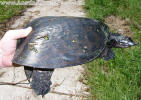 |
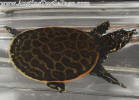 |
|
Adult Male Florida Softshell
Photo by Tom C. |
Hatchling Florida Softshell
Photo
by Richard Lunsford |
|
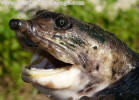 |
|
Adult Female Florida Softshell
Photo by Tom C. |
7.) Smaller Female
Spiny Softshells –
Apalone spiniferus
Description: Very flattened-bodies turtles
with long, tapering faces/noses, lips, strongly webbed feet & leathery,
skin-covered flexible shells. Hatchlings cute & in some subspecies (i.e.:
Eastern spiny) have beautiful rings/ocelli. Females drastically larger than
males & the rings/ocelli diffuse out to form lichen-like patches. Slider-like care but beware
abrasive objects in the tank; at least a container of sandy substrate will be
appreciated. Size: Females can
reach SCL 18”! (And the head sticks out past that).
Pro.s: Active, elegant swimmers, enthusiastic
feeders, beautiful & very distinctive from hard-shelled turtles. Capable
fishermen. Males often retain juvenile coloration fairly well. Spiny softies are
more prone to bask on emergent objects than smooth softies. Russ Gurley in Keeping & Breeding Freshwater Turtles Page 127 states hatchling spiny
softshells are somewhat more resilient & accepting of a wider range of water
conditions than other species of softshells. Easy to find & cheap.
Con.s: Prone to infection from minor
injuries. Leathery shell offers little protection from predators. More prone to
dehydration out of water than many species. Prefer sandy section of substrate to
burrow into. Fast enough they can be hard to catch in the tank. Can kill your
fish. Even smaller female spinies get quite large & should have at a minimum
a 125 gallon tank, & may well out-grow it.
Availability & Cost: Common in the pet trade.
Cost ~ $10-15 for hatchlings.
|
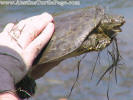 |
|
Medium-sized (SCL ~ 9”, give or take) Female
Eastern Spiny Softshell
Photo
by Wallob Hebel |
8.) Smaller Female Smooth Softshells –
Apalone
muticus
Description: Very flattened-bodies turtles
with long, tapering faces/noses, lips, strongly webbed feet & leathery,
skin-covered flexible shells. Hatchlings cute. Anterior carapace has neither
spines nor tubercles. Females drastically larger than males. Slider-like care
but beware abrasive objects in the tank; at least a container of sandy substrate
will be appreciated. Size: Females 6.5 – 14 in, males 4.5 – 7 in.
Pro.s: Active, elegant swimmers, enthusiastic
feeders, beautiful & very distinctive from hard-shelled turtles. Capable
fishermen. Males may be slightly smaller than spiny softshells. Cheap.
Con.s: Prone to infection from minor
injuries. Leathery shell offers little protection from predators. More prone to
dehydration out of water than many species. Prefer sandy section of substrate to
burrow into. Fast enough they can be hard to catch in the tank. Can kill your
fish. Juveniles can gorge themselves to death. Smooth softies are less prone to
bask on emergent objects than spiny softies (many enclosure basking spots are
emergent objects). Harder to find than spiny softies. Have a reputation for
being less hardy than spinies. Even smaller female smooths get quite large &
should have at a minimum a 125 gallon tank, & may well out-grow it.
Availability & Cost: Somewhat uncommon in the
pet trade. Cost ~ $10-15 for hatchlings.
9.)
North American Wood Turtle –
Glyptemys insculpta
Description: Medium-large semi-terrestrial
(heavily utilizing both land & water) with a brown carapace but red-orange skin
on the base of the body. Hatchlings are drab brown but with growth progressively
more beautiful. Carapace is rough & scutes have a concentric circle appearance
that fades with age. Longer tails than most basking species. Water area like a
slider’s but shallower water with more supporting structures to clamber about
on. Also need a substantial land section. Size: 7 – 9.5”.
Pro.s: Omnivorous, attractive, rep. for
unusual intelligence/personality, fairly easy to find. Northeastern &
North-central range so hibernation-capable.
Con.s: Males mutually aggressive & mating is
brutal so plan to keep one per enclosure. May dominate other species, too. Need
large enclosures/land & water sections. Need cooler temp.s than many species (so
sharing water areas with some species isn’t workable) & at risk to overheat in
outdoor enclosures in warm climates.
Availability & Cost: Fairly easy to find
online & at expo.s but expensive. Cost ~ $60-125 for hatchlings.
|
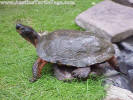 |
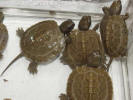 |
|
North American Wood Turtle
Photo
by Billy |
North American Wood Turtle Hatchlings
Photo
by Richard Lunsford |
10.)
Ornate Box Turtle -
Terrapene ornata ornata
Description: Medium-sized terrestrial turtle
which likes to soak. Steeply domed carapace, single-hinged plastron, can close
the shell tightly, fairly colorful carapace & head. Size: Ornate 4 – 5”
(up to 6).
Pro.s: Omnivorous (but more carnivorous than
Eastern box). Smallest North American box turtle. Older juveniles & adults
fairly affable/interactive with humans & shell provides good protection. Eager
feeders. Can be low-maintenance in year-round outdoor enclosures in compatible
climates. Fairly easy to find.
Con.s: Dogs can chew through the shell
quickly. Wild-caught (usual for pet store adults) apt to contain parasites, may
try to hibernate despite not being allowed to do so, & may adjust poorly to
captivity. Require clean water yet preferentially excrete wastes in it. Need
spacious enclosures offering varying temp.s & humidities. May not adapt well to
clear-walled enclosures. May tunnel out of outdoor enclosures. Moderately
expensive. Hatchlings can be maddeningly shy & slow to eat. Ornate box turtles
have a reputation for being prone to health problems in captivity & are
considered a poor choice as a pet.
Availability & Cost: Somewhat uncommon as
hatchlings in the pet trade. Wild-caught adults too common in pet stores. Cost ~
$20-40 Hatchlings.
Section V
– High-Level Turtles.
Either require high-cost & large enclosures or
are otherwise very expensive &/or difficult to maintain well.
1.) Male
Alligator Snapper -
Macroclemys temmincki Hatchlings ~ $25-35.
Description: Large, heavy-bodied & thick turtle (up
to 150 lbs healthy weight, over 200 lbs obese) with a rough, bark-like carapace,
very reduced plastron, strong & clawed legs, powerful jaws, fairly short-range
strike & aggressive self-defense strategy. Muzzle is longer & has a more hooked
‘beak’ look than a common snapper. Long tail. Bottom-walking species sedentary
in the wild (not as active a hunter as the alligator snapper). Care is mud
turtle-like on an enormous scale (reaching the surface for air without swimming)
but smaller land area needed. Variably dark-brown & drab. Inhabit large,
permanent water bodies (mainly rivers). Sizes: 15 – 26 in. Males can
exceed 200 pounds (150 lbs is large for a male; heavier weights entail obesity).
Females much smaller; reach around 60 lbs).
Pro.s: Omnivorous but often predominantly
carnivorous in captivity. Fairly hardy. Capable fishermen via wiggling a
worm-like tongue lure (unique to this species). Has a very wild, ‘prehistoric’
look. Safer to handle than a common snapper due to lack of distance ‘power
strike’ & fast body spin. Growth rate moderate if not over-fed. Less active than
common snappers so don’t require much larger enclosures. Parts of range in
temperate climate so should be hibernation-capable (but a riverine species).
Con.s: Very large, heavy turtle with very
powerful jaws & fairly aggressive disposition (could cost you fingers). Males
much larger than females. Prone to obesity & grow rapidly if overfed. Need large
enclosures (300 gallon+; for a full-size adult likely 800+ gallons) with
powerful filtration. Hatchlings can’t be sexed by most for years. Predatory &
may kill other turtles. Tend to eat your fish. People seeking these often get
common snappers by mistake; be very sure of what you’re buying.
Availability & Cost: Fairly uncommon at
online vendors. Cost ~ $25-35 for hatchlings.
|
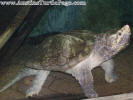 |
|
Large Adult Male Alligator Snapper
Photo
by Richard Lunsford |
2.) Large adult female North American Softshells
– all species.
Description: Very flattened-bodies turtles
with long, tapering faces/noses, lips, strongly webbed feet & leathery,
skin-covered flexible shells. Hatchlings cute but adult coloration often less
ornate. Females drastically larger than males. Slider-like care but beware
abrasive objects in the tank; at least a container of sandy substrate will be
appreciated. Female Florida softshells can hit SCL 24” (2 feet), spinies 18,” &
smooths 14.”
Pro.s: Active, elegant swimmers, enthusiastic
feeders, beautiful & very distinctive from hard-shelled turtles. Capable
fishermen. Many hibernate in part of their range. Eastern Spiny & Florida easy
to find & cheap.
Con.s: Prone to infection from minor
injuries. Leathery shell offers little protection from predators. More prone to
dehydration out of water than many species. Prefer sandy section of substrate to
burrow into. Fast enough they can be hard to catch in the tank. Can inflict
severe lacerations & scratches to owner & long neck gives it range. Can kill
your fish. Hibernation-worthiness may be limited in some species/subspecies.
These turtles are enormous. Even a 240 gallon aquarium is insufficient; massive
custom enclosures ~ 500+ gallons are needed.
Availability & Cost: Common in the pet trade.
Cost varies.
|
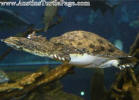 |
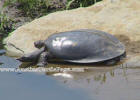 |
|
Large Female Softshell
Photo
by Richard Lunsford |
Large Adult Female Spiny Softshell
Photo
by Wallob Hebel |
3. Bog Turtle -
Glyptemys muhlenbergii
Description: Very small mildly domed black
turtle with large orange or yellow patches behind the eyes. Size: 3 - 4.5" SCL.
Pro.s: Omnivorous & can feed on land or in
water. Very small & quite attractive. Northeastern native so
hibernation-capable.
Con.s: Palludarium-style enclosure
replicating native environment or just basic needs requires some expertise. Very
imperiled in the wild, very expensive, hard to acquire legally (or illegally),
protected in many places in the U.S. (& CITIES Appendix I for you non-U.S.
shoppers), & has a reputation for being prone to health problems in captivity,
requiring fairly advanced care knowledge & practice. Recommendation: should only
be purchased by advanced keepers planning to propagate the species.
Availability & Cost: Very hard to acquire. At
the Daytona Captive Reptile Breeders’ Expo. 2004 they were in short supply, $900
apiece & sold only to buyers with a Florida Drivers’ license.
Known Legalities: In Florida can only be sold
to residents with Fl Drivers' license. In PA requires permit to own. Endangered
or threatened in all 12 of the states it occurs in. Consult your state laws for
current regulations.
|
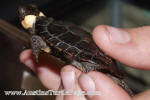 |
|
Bog Turtle
Photo
by Richard Lunsford |
Appendix I.) List of North American Turtles covered
in this article.
Not all North American turtles are covered in
this article (i.e.: flattened musk, gopher & desert tortoises, some maps, etc…).
I chose a representative majority of those species apt to be purchased or
wild-caught by pet seekers.
1.)
Sliders.
a.
Red-eared (RES).
b.
Yellow-belly (YBS).
c.
Cumberland.
2.)
Cooters.
a.
River.
b.
Peninsula.
c.
Florida.
d.
Florida Red-belly.
e.
Alabama Red-belly (included only because it might be wild-caught).
f.
Red-belly.
3.)
Painted Turtles.
a.
Southern.
b.
Midland.
c.
Eastern.
d.
Western.
4.)
Map Turtles.
a.
Texas.
b.
Cagles.
c.
Common.
d.
Mississippi.
e.
Ouachita.
f.
False.
g.
Barbours.
5.)
Chicken Turtles.
6.)
Snappers.
a.
Common.
b.
Alligator.
7.)
Mud Turtles.
a.
Eastern.
b.
Mississippi.
c.
Florida.
d.
Yellow.
e.
3-Striped.
8.)
Musk Turtles.
a.
Stinkpot.
b.
Razorback.
c.
Loggerhead.
d.
Stripe-neck.
9.)
Spotted Turtles.
10.)
Bog Turtles.
11.)
Blandings Turtles.
12.)
Pacific Pond Turtles.
13.)
North American Wood Turtles.
14.)
Softshells.
i.
Spiny.
ii.
Smooth.
iii.
Florida.
iv.
Chinese* (Not a North American species, but introduced into Hawaii (a state),
common in parts of the U.S., & smaller size made it of interest.
Appendix II.) North American Turtles by Difficulty
Level.
Level I.) The Best Starter
Turtles: Male Texas Map, Male Common Map, Southern Painted, Midland
Painted (mainly males), Stinkpot, Razorback musk.
Level II.) Second Choice
Starter Turtles: Male Cagles Map, Male Chicken, Male Black-Knobbed Map,
Loggerhead Musk, Stripe-neck Musk, Eastern Mud, Mississippi Mud, Yellow Mud,
3-Striped Mud.
Level III.) Medium-Level
Turtles: Sliders (North American), Cooters (all), Eastern & Western
Painted, Most Maps (including Mississippi, Ouachita, False, Female common,
Barbour’s, female Texas & Cagles, etc…), female chicken turtles, Chinese
softshells, male spiny & smooth softshells, spotted turtles, Florida mud,
Eastern & 3-Toed box turtles.
Level IV.) Medium-Hard
Turtles: Blandings, Pacific Pond, Diamondback Terrapin, Common Snapper,
Female Alligator Snapper, Smaller female spiny & smooth softshells, Male Florida
softshells, Ornate box turtles.
Level V.) High-Level Turtles:
Male Alligator Snappers, Large Female North American Softshells (esp. Floridas),
Bog Turtles.
Appendix III.) North American Turtles by Ease of
Acquisition.
Easy to Acquire:
Red-eared slider, Florida Red-belly Cooter, all 4 Painted subspecies
(southern/midland/eastern/western), Mississippi Map, stinkpots, Spiny Softshells
(mainly Eastern spiny softshells), Florida softshells., pet store box turtles
(adult, wild-caught, not recommended).
Fairly Easy to Acquire:
YBS, Peninsula Cooter, Texas Map, Ouchita Map, False Map, Diamondback Terrapin
(as a group; specific subspecies may be harder to track down), Razorback Musk,
Mississippi Mud, Spotted Turtle, North American Wood Turtle, Common Snapper,
Alligator Snapper.
Fairly Uncommon in the Trade:
Cumberland Slider, River Cooter, Cagles Map, Common Map (ironic but true),
Blandings, Florida Chicken Turtles, Eastern Mud, 3-Striped Mud, Yellow Mud
(adult), Smooth Softshells, Chinese Softshells, Eastern box turtle hatchlings.
Uncommon: Rio Grande
Cooters, Barbour’s Map, Pacific Pond, Western Chicken Turtle, Loggerhead Musk,
Stripe-neck Musk, Yellow Mud (hatchling), Florida Mud.
Hard to Acquire: Bog
Turtle. Alabama Red-belly (endangered & illegal!).
Appendix IV.) North American Turtles by Cost.
Cost of Acquisition. Total Cost
of Ownership (TCO) tends to be much greater over time. A good example is to
compare a hatchling southern painted (~ $15) with a hatchling spotted turtle (~
$125). Even if both are maintained in 75 gallon aquaria (painted for size,
spotted to have adequate land & water), lighting, filtration, etc…won’t vary
that much. Enclosure & other equipment (filter, UV-B bulb, etc…) run several
hundred either way, dwarfing the purchase price of the turtle itself.
Cheap (up to around
$15): RES, YBS, Cumberland Slider, Florida Red-belly Cooter, Peninsula
Cooter, River Cooter, all 4 Painted subspecies (southern, midland, eastern,
western), Mississippi/Ouachita/False Map, stinkpots, 3-Striped Mud, Eastern Mud,
Mississippi Mud,
Affordable (~ $20 -
$50): Rio Grande Sliders (a.k.a. ‘ornate RES’), Common Map, Texas Map,
Black-Knobbed Map, Loggerhead Musk, Alligator Snapper, 3-Toed Box, Eastern Box,
Ornate Box.
Expensive (~ $75 -
$150): Albino & Pastel RES, Rio Grande Cooters, Barbour’s Maps, Cagles Maps,
Chicken Turtles, Stripe-neck Musk, Spotteds, Blandings, North American Wood
Turtles.
Very Expensive ($200+):
Pacific Pond Turtles.
Extremely Expensive
($500+): Bog Turtles.
Appendix V.) North American Turtles by Size.
Taking into account both SCL (superior carapace
length measurement) & general bulk (a 12” common snapper is a good deal larger
than a 12” cooter).
Small: Male Texas,
Cagles & Black-knobbed map, Southern Painted, Female Midland Painted, Musk
(stinkpot, razorback, loggerhead, stripe-neck), Mud (Eastern, Mississippi,
Florida, 3-striped, Yellow), Spotted & Bog.
Medium: Female
Texas, & Cagles Maps, Common Maps, most male Maps (including Mississippi,
Ouachita, False), male Sliders, male Chicken Turtles, female Midland, either
gender Eastern Painted, male & some female Western Painted, smaller male Spiny,
Smooth & Chinese Softshells, Pacific Pond Turtles, all North American Box
Turtles.
Large: Female
sliders, female Western & larger Eastern painted, female Barbour’s maps, all
cooters (females moreso than males), female Chicken turtles, female Chinese &
Smooth Softshells, larger male & small female Spiny Softshells, male Florida
Softshells.
Very Large: Larger
female Smooth & Spiny Softshells, female Florida Softshells, Common Snappers,
Female Alligator Snappers.
Huge: Male Alligator
Snappers.
Appendix VI.) North American Turtles by Minimum
Enclosure Size.
These are minimum enclosure sizes for a
moderately comfortable existence. In nearly all cases at least the next step up
in enclosure size is recommended. These are also judgment calls & some will
disagree with me.
20 Gallon Long (not
regular) Aquarium – Smaller male Texas maps. Smaller mud turtles (such
as 1 or at most 2 3-striped). A 20 gallon long is cramped even for these
animals. Musk are allegedly more active than mud & so not included. Mud & musk
can fight & seriously injure each other.
29 Gallon Aquarium –
Male Southern Painted, male Texas map, male Cagles map, male Black-Knobbed map,
Musk (stinkpot, razorback, loggerhead, stripe-neck), larger mud turtles
(individuals, not so much species) or pairs of muds.
55 Gallon Aquarium –
Female Southern Painted, male Midland Painted, male common, Mississippi or
Ouachita map, Spotted Turtles, Pacific Pond Turtles.
75 Gallon Aquarium –
Male Sliders, male Midland, Eastern or Western Painted, smaller female Maps
(i.e.: Cagles, Texas), Chinese & male Spiny or Smooth Softshell
125 Gallon Aquarium –
Female Sliders, male Cooters, most female maps (common, Mississippi, Ouachita),
male Barbour’s maps, Blandings, North American Wood, male Florida Softshell,
female Smooth & smaller female Spiny Softshells.
240 Gallon Aquarium –
Larger female Cooters (particularly river cooters), female Barbour’s Map, larger
female Spiny Softshells, Common Snappers.
300 Gallon Stock Tank (i.e.:
Rubbermaid stock tank) – Large female North Amercian Softshells, Common
snapper, female Alligator Snapper.
Massive (500 gallon+) Custom
Enclosures – Male Alligator Snapper.
|
|
|
 |
|
 |
|